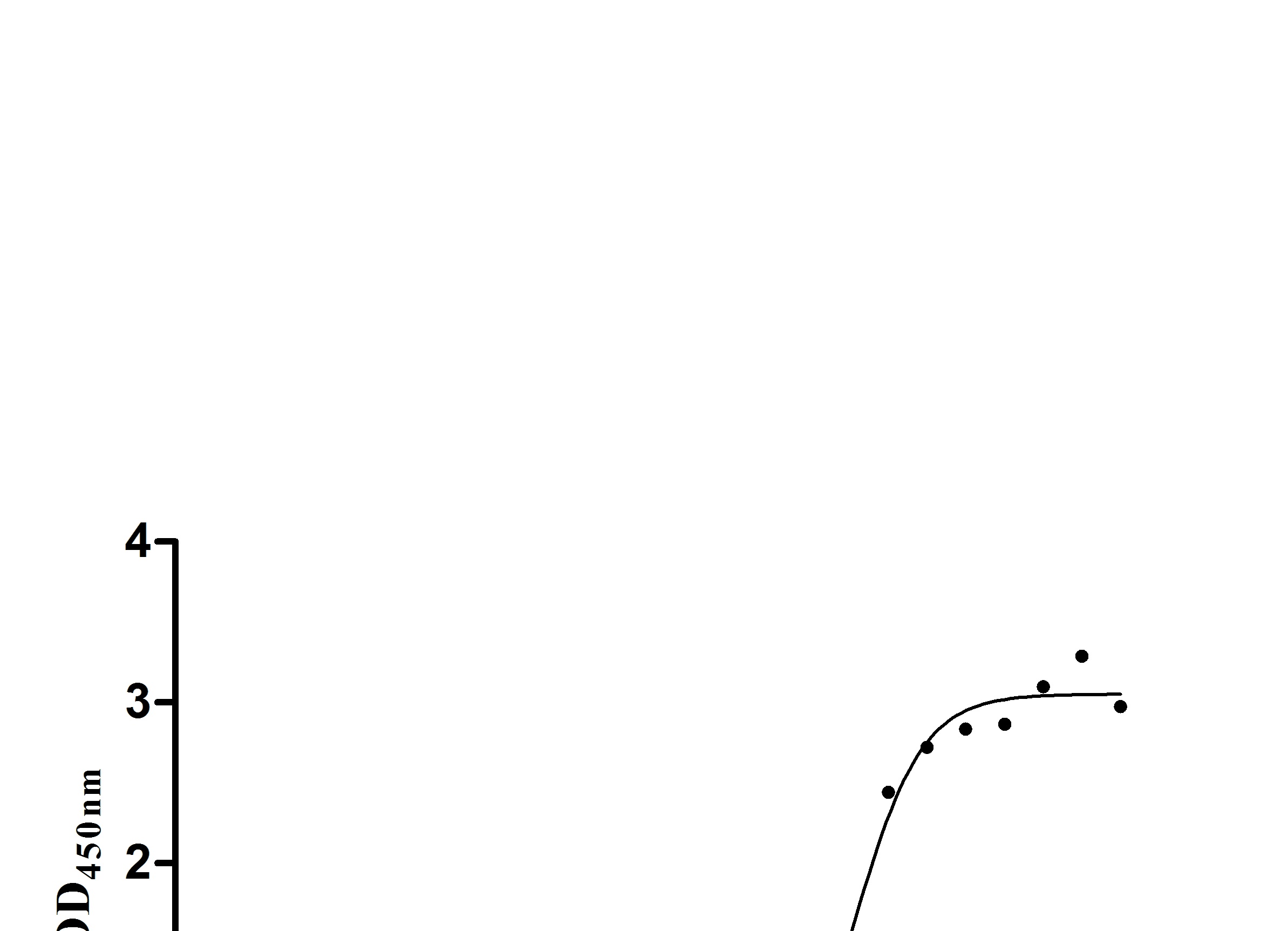Recombinant human CD44 protein is produced through gene cloning, plasmid preparation, expression, purification, and analysis. Primers are used to amplify the 21-220 aa region of the human CD44, which is then ligated into a plasmid with a C-terminal hFc-tag gene. Mammalian cells are transfected with the recombinant plasmid, and selective antibiotics are applied to screen the successfully transfected cells. The CD44 protein is extracted by lysing the cells and purified from the supernatant using affinity chromatography. Its purity is confirmed via SDS-PAGE at >90%, with endotoxin levels below 1.0 EU/μg detected by the LAL method. Functional ELISA shows this human CD44 binding to the CD44 mouse monoclonal antibody(CSB-MA004938A0m), with an EC50 of 11.89-14.94 ng/mL.
Human CD44 antigen is a multifunctional cell surface glycoprotein that plays a pivotal role in various physiological and pathological processes, including cell adhesion, migration, and immune responses. CD44 is primarily recognized for its interaction with hyaluronic acid (HA), which is crucial for mediating cellular behaviors such as chemotaxis and attachment, particularly in lymphocytes [1][2]. The cytoplasmic tail of CD44 interacts with the actin cytoskeleton through proteins like ankyrin and ERM (ezrin, radixin, moesin), facilitating cell migration and influencing inflammatory responses [3].
In the context of inflammation, CD44 is involved in the recruitment and localization of immune cells at sites of injury or infection. Its expression is regulated by various inflammatory stimuli, including lipopolysaccharides (LPS) and cytokines, which enhance CD44 levels in monocytes and other immune cells [4]. This regulation underscores CD44's role in orchestrating immune responses, as it not only aids in cell adhesion but also modulates the secretion of pro-inflammatory cytokines [5]. Furthermore, CD44 has been shown to suppress TLR-mediated inflammation, indicating its regulatory function in immune signaling pathways [6].
In cancer biology, CD44 is recognized as a marker for cancer stem cells and is implicated in tumor progression, metastasis, and immune evasion. Its expression is often associated with poor prognosis in various cancers, including gastric cancer and glioma [7-9]. CD44 facilitates tumor cell migration and invasion by interacting with the extracellular matrix and influencing signaling pathways that promote cell survival and resistance to therapies [7][10]. Moreover, the expression of CD44 is linked to the polarization of tumor-associated macrophages, contributing to an immunosuppressive tumor microenvironment [9].
Additionally, CD44's involvement extends to metabolic disorders, where it plays a role in adipose tissue inflammation and insulin resistance, particularly in obesity and type 2 diabetes [11][12]. The depletion of CD44 in adipose tissue has been shown to ameliorate systemic glucose intolerance, highlighting its significance in metabolic regulation [11].
References:
[1] A. Santarelli, M. Mascitti, C. Rubini, F. Bambini, A. Zizzi, A. Offidani, et al. Active inflammatory biomarkers in oral lichen planus, International Journal of Immunopathology and Pharmacology, vol. 28, no. 4, p. 562-568, 2015. https://doi.org/10.1177/0394632015592101
[2] S. Yamada, S. Itai, T. Nakamura, M. Yanaka, M. Kaneko, & Y. Kato. Detection of high cd44 expression in oral cancers using the novel monoclonal antibody, c44mab-5, Biochemistry and Biophysics Reports, vol. 14, p. 64-68, 2018. https://doi.org/10.1016/j.bbrep.2018.03.007
[3] E. Rampanelli, M. Dessing, N. Claessen, G. Teske, S. Joosten, S. Pals, et al. Cd44-deficiency attenuates the immunologic responses to lps and delays the onset of endotoxic shock-induced renal inflammation and dysfunction, Plos One, vol. 8, no. 12, p. e84479, 2013. https://doi.org/10.1371/journal.pone.0084479
[4] K. Gee, W. Lim, W. Ma, D. Nandan, F. Diaz-Mitoma, M. Kozlowski, et al. Differential regulation of cd44 expression by lipopolysaccharide (lps) and tnf-α in human monocytic cells: distinct involvement of c-jun n-terminal kinase in lps-induced cd44 expression, The Journal of Immunology, vol. 169, no. 10, p. 5660-5672, 2002. https://doi.org/10.4049/jimmunol.169.10.5660
[5] G. Windt, C. Veer, S. Florquin, & T. Poll. Cd44 deficiency is associated with enhancedescherichia coli-induced proinflammatory cytokine and chemokine release by peritoneal macrophages, Infection and Immunity, vol. 78, no. 1, p. 115-124, 2010. https://doi.org/10.1128/iai.00949-09
[6] H. Kawana, H. Karaki, M. Higashi, M. Miyazaki, F. Hilberg, M. Kitagawa, et al. Cd44 suppresses tlr-mediated inflammation, The Journal of Immunology, vol. 180, no. 6, p. 4235-4245, 2008. https://doi.org/10.4049/jimmunol.180.6.4235
[7] K. Dzobo and M. Sinkala. Cancer stem cell marker cd44 plays multiple key roles in human cancers: immune suppression/evasion, drug resistance, epithelial–mesenchymal transition, and metastasis, Omics a Journal of Integrative Biology, vol. 25, no. 5, p. 313-332, 2021. https://doi.org/10.1089/omi.2021.0025
[8] W. Hou, Z. Hou, & H. Ji. Cd44 is a prognostic biomarker and correlated with immune infiltrates in gastric cancer, BMC Medical Genomics, vol. 15, no. 1, 2022. https://doi.org/10.1186/s12920-022-01383-w
[9] Y. Xiao, K. Yang, Z. Wang, M. Zhao, Y. Deng, W. Ji, et al. Cd44-mediated poor prognosis in glioma is associated with m2-polarization of tumor-associated macrophages and immunosuppression, Frontiers in Surgery, vol. 8, 2022. https://doi.org/10.3389/fsurg.2021.775194
[10] P. Pongcharoen, A. Jinawath, & R. Tohtong. Silencing of cd44 by sirna suppressed invasion, migration and adhesion to matrix, but not secretion of mmps, of cholangiocarcinoma cells, Clinical & Experimental Metastasis, vol. 28, no. 8, p. 827-839, 2011. https://doi.org/10.1007/s10585-011-9414-8
[11] K. Kodama, M. Horikoshi, K. Toda, S. Yamada, K. Hara, J. Irie, et al. Expression-based genome-wide association study links the receptor cd44 in adipose tissue with type 2 diabetes, Proceedings of the National Academy of Sciences, vol. 109, no. 18, p. 7049-7054, 2012. https://doi.org/10.1073/pnas.1114513109
[12] L. Liu, K. Kodama, K. Wei, L. Tolentino, O. Choi, E. Engleman, et al. The receptor cd44 is associated with systemic insulin resistance and proinflammatory macrophages in human adipose tissue, Diabetologia, vol. 58, no. 7, p. 1579-1586, 2015. https://doi.org/10.1007/s00125-015-3603-y


-SDS.jpg)
-1.jpg)
-2.jpg)
-AC.jpg)
-HPLC.jpg)





